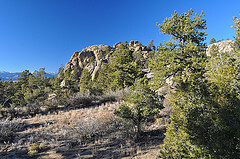Written by Scott Braden, Wilderness and Public Lands Advocate
Last month’s designation of Browns Canyon National Monument was a tremendous victory for conservation and for Coloradans. We know that conservation of our public lands is a core value; in a recent Colorado College poll, 82% of Westerners believe that it’s very important to conserve and protect natural areas for future generations. We have a deeply held belief that ties our iconic Colorado landscape very closely to our identity as Coloradans, and that translates into a care for the land that extends to protecting what we have to share with those yet to come.
 Browns Canyon was designated a national monument by President Obama using his authority under the 1906 Antiquities Act, a tool used by most American presidents since it was first wielded by Theodore Roosevelt to protect Devils Tower in Wyoming. Since that time, it has been used to protect monuments large and small, places cultural and wild, including the Grand Canyon, Grand Tetons and our own Dinosaur National Monument.
Browns Canyon was designated a national monument by President Obama using his authority under the 1906 Antiquities Act, a tool used by most American presidents since it was first wielded by Theodore Roosevelt to protect Devils Tower in Wyoming. Since that time, it has been used to protect monuments large and small, places cultural and wild, including the Grand Canyon, Grand Tetons and our own Dinosaur National Monument.
A bipartisan group of Colorado elected officials has been trying to protect Browns Canyon in Congress for over a decade, with notable attempts by former Republican Congressman Joel Hefley and former Senator Ken Salazar. Most recently former Senator Mark Udall sponsored a bill to designate Browns a national monument. Despite strong local support and great effort by these lawmakers, politics and an often dysfunctional Congress stymied these efforts. This is why, last December, Senator Michael Bennet and Governor John Hickenlooper joined Mark Udall in calling on President Obama to use his authority to get the job done. Although often controversial, use of the Antiquities Act to protect American lands is a routine and appropriate path to protection.

Congressman Doug Lamborn was quick to decry the designation of Browns, tossing out his tired talking point that there was insufficient consensus, that local voices were ignored. The truth is, over 500 people in December showed up for a public meeting in Salida to show their support, while U.S.Representative Lamborn didn’t even bother to attend.
Browns Canyon National Monument is just the latest in a string of conservation wins, driven by our Colorado ethic of caring for our wildlands and open spaces. Late last year, Congress got off it’s proverbial rear end and passed the bipartisan Hermosa Creek Watershed Protection Act. This mountain stream, near Durango, now boasts over 100,000 protected acres , including the 37,000 acre Hermosa Creek Wilderness. The victory was due in no small part to a committed grassroots-driven effort that brought stakeholders together, united in common purpose to conserve these lands for future generations.
 Finally, last year a legal settlement in the courts brokered protection for the summit of Northwest Colorado’s wildlife-rich Roan Plateau, drawing a protracted legal battle to a close, with all parties agreeing that the mesa top must be protected from drilling.
Finally, last year a legal settlement in the courts brokered protection for the summit of Northwest Colorado’s wildlife-rich Roan Plateau, drawing a protracted legal battle to a close, with all parties agreeing that the mesa top must be protected from drilling.
Three conservation victories, each accomplished differently. Browns through executive action, Hermosa through Congress, and Roan Plateau through our system of courts. Each is a legitimate means in service to protecting our Colorado natural legacy. Each speaks to the imagination and flexibility of the stakeholders involved to find a path forward, sometimes even when the odds weren’t good.
These conservation victories speak to a “Colorado way” of getting things done to protect our public lands treasures. They each involved listening to stakeholders and the public, collaboration, and principled compromise. But in the end, all participants involved in each process bought in to the notion that we could work together, talk together and chart the future of our forests and public lands.
Your Wilderness Advocate,
Scott Braden



